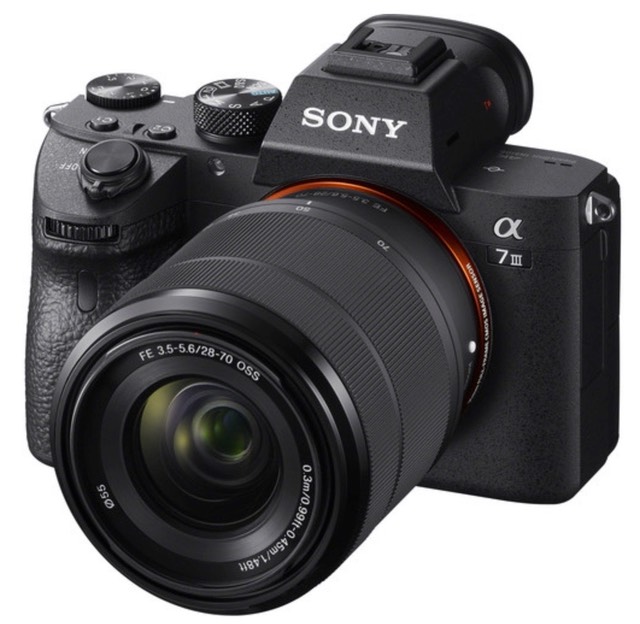
What is It?
I skipped a generation in the A7 body reviews when I didn't review the Mark II. So we need to get up to date here with some of the key differences between the three models. That's particularly true because Sony has been keeping older cameras still available to buy, so I don't expect the A7 Mark II to disappear overnight now that the Mark III is here. It will just sell at a discount compared to the A7 Mark III.
| A7 | A7m2 | A7m3 | |
|---|---|---|---|
| introduced | 2013 | 2014 | 2018 |
| sensor | 24mp FSI |
24mp FSI | 24mp BSI |
| IS | no | 4.5 stops |
5 stops |
| fps | 5 | 5 | 10 |
| rear LCD |
1.23m tilt |
1.23m tilt |
920k dot touch tilt |
| EVF | 2.36m 0.71x |
2.36m 0.71x |
2.36m 0.78x |
| Top Video |
1080P/60, 50Mbps |
1080P/60, 50 Mbps |
2160P/30 100Mbps |
| Battery | FW50, 340 CIPA |
FW50, 350 CIPA |
FZ100, 710 CIPA |
| Weight | 474g | 600g | 650g |
| Focus | 117 PD, 25 CD |
117 PD, 25 CD |
693 PD, 425 CD |
| Buffer | 42 (raw) |
50 (raw) |
89 (raw) |
| USB | 2.0 | 2.0 | 3.1 |
| SD |
1 SD |
1 UHS-I |
1 UHS II, 1 UHS 1 |
| silent shoot? |
No | No | Yes |
The A7m3—That's how I'll refer to it for the rest of the review—has many external and internal differences from the earlier models. Let's start inside.
The real change inside really revolves around a new sensor. Two key differences stand out: we've gone to Back Side Illumination, and we've added hundreds of phase detect (PD) focus points across more of the sensor (93% of the frame). As part of the sensor overhaul we also get UHD 4K at 30 fps. Just in front of the sensor we get a new shutter that can make 10 fps.
On the outside, the A7m3 body changes to match the A9 and A7r Mark III designs: a bit of growth in size and weight mostly center on the hand grip, a new and larger battery, the focus position joystick, plus the dual SD slots (though only one is UHS-II and there's still no slot function programming that's overly useful).
Plenty of other small changes abound, including modest improvements to the viewfinder magnification, in-body image stabilization, and more.
We do have to remember that the A7m3 is at the bottom of the Sony full frame lineup. That means that there are compromises throughout. Some of that is the 2.36m dot OLED viewfinder that comes along for the ride (the A7Rm3 got a better EVF, as did the A9), some of that is a not so great touchscreen implementation on a screen that no longer has the white dot brighteners, and some of it is slight changes in build quality and parts usage.
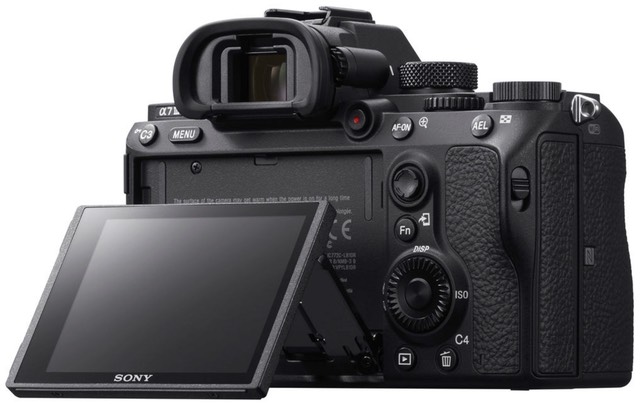
It’s clear that Sony was hard at work trying to figure out the compromises that would make the A7m3 a clear entry full-frame camera leader, but also keep its price from lifting above the US$2000 mark. Most of these cost reduction decisions aren’t easily visible at first, but they’re there. So when Sony described the A7m3 as their “basic” camera at its introduction, they weren’t kidding. Many of the parts decisions are those you’d find on a basic camera at this price point. Sony went a bit further in a few cases, and so the A7m3 does tend to play a bit above expectations in some areas.
Overall, despite all the changes, just looking at the most recent two generations of A7 together you really don't see the differences easily. To a large degree, the A7m3 is an iterative update; it's just that a lot of things have been iterated, and a few hidden things have been upgraded considerably.
In video, a lot of folk will be excited to learn that at 4K and 24 fps the camera is actually shooting at 6K with no crop, and thus is over-sampling before rendering the final pixels. But the footnotes start coming in fast and furious in video. If you change to 4K and 30 fps, the camera now is cropping at 1.2x and shooting a 5K capture; still over-sampling, but not as much and your angle of view just got compressed. I understand why these things happen, but they can be annoying in practice.
1080P now goes all the way to 120 fps. And, unlike Nikon, Sony lets you do this both ways: record at a true 120 fps, or record 120 fps encoded as 24/30 fps. What's the difference? Well, you can playback 120 fps at 120 fps and get normal motion, or you can post-code to 30 fps and get 4x slow motion. If you encode in the camera to 30 fps and play back normally you get 4x slow motion, but you don't really have the ability to playback the captured 120 fps at 120 fps any more (at least not without some trickier post processing). This, like many things in the video abilities of this camera, is a nice touch. The integration of the Sony still and video imaging teams is resulting in some nice crossover touches like this.
The A7m3 video also allows for Log and HLG capture, which are useful for later grading, unlike the A9, which is a bit surprising. The 4K video is recorded as XAVC S 4K, while 1080P can be recorded as either XAVC S HD or AVCHD.
The A7m3 is made in China and lists right at the US$2000 mark. That seems to be the magic price target that Canon, Nikon, and Sony have for full frame cameras that are designed for broad general consumer use.
In a fit to cut costs, the printed manual that comes with the camera is not complete and mostly un-useful, plus you don't get a true battery charger (only a USB cable and AC-to-USB plug). Sony's BC-QZ1 Battery Charger is another US$88. Third party battery chargers that work well are as little as US$14 for the Power2000 one.
Source of the review camera: B&H one month loaner.
How's it Handle?
Okay, we’re now on the third generation of full frame mirrorless cameras from Sony. My expectations in handling go up with each iterative generation, as Sony has had five years and a lot of customer feedback to assess and put into practice.
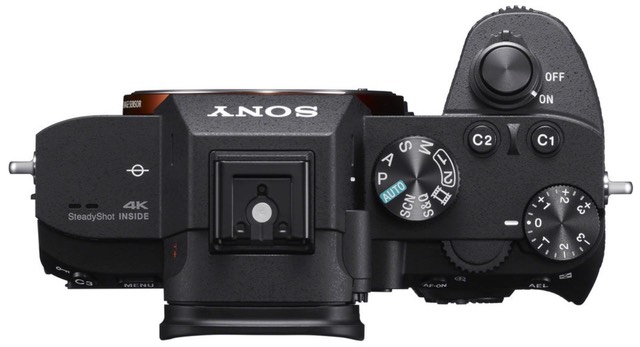
Here’s the problem: many of my early complaints about handling with the A7 still really apply with the A7m3. And those really all revolve around the menu system and setting up the camera. The hand grip and many of the user controls have been improved. It’s the menu system that is going to get the bulk of my comments here. Let me put it delicately: don’t go out on an important shoot the first day with your new A7m3: you’ll almost certainly miss an image because you didn’t get something set right, didn’t understand how something worked, or didn’t understand the Sony nomenclature.
Little things get in the way fast. The lower grade rear LCD on the A7m3 isn’t particularly visible in bright light. At least not at the default settings. But seeing the menus well enough to find the control you need to reset (Monitor Brightness, Setup page 1) is a problem, and if you’re new to the Sony menu system, you’re going to find a bunch of LCD settings scattered across different menus, which will confuse you and slow you down in finding the right one. There is a Display page under the Camera 2 pages, after all, which is where you’ll think you’ll find the item in question.
The more you use the Sony menus, the more comfortable you’ll be. But frankly, that’s you getting used to Sony’s disorganization and nomenclature, not Sony doing anything to help you with discovery. Lest you think I’m exaggerating, it isn’t just LCD brightness you’ll be struggling to find a solution for the first time you start using the A7m3 coming from another system (or after leaving the camera in the closet for awhile).
You’d think that Touch abilities on the LCD would help you navigate the menus and find the hidden selection you’re interested in faster. Nope. At this point, I’d say that the Nikon D7500’s touch screen implementation just blows away what Sony has accomplished. And yes, that’s a dig. A lower-priced consumer crop sensor camera is far easier to navigate than Sony’s high-end entry camera.
The menu system still has no help system, either. This just makes setting things more difficult to understand (see next). Update: Well, it does have a help system, but...someone pointed me to Sony's solution to this: you have to set a button assignment to the in-camera guide. You then press that button when a menu item is selected. I can't even begin to point out the things wrong with this. First, a help system needs to be not buried in a function you have to set in a confusing menu system, but immediately discoverable by someone new to the camera. The way Sony is doing this is completely backwards. Help first, customization second. Second, we have the issue of buttons: a limited number of buttons and an infinite number of desirable uses. Sony also has issues with button overload. The logical button to assign to In-Camera Guide (the help system, buried in those 23 pages of settings you can assign to a button) is C3. C3 is already overloaded to be Protect in playback, and assigned a focus mode in shooting, yet you could assign help to when the menus are present (which is what Nikon does). Finally, after turning this on and perusing it, well, the help pretty much is unhelpful. Finder Frame Rate is described by the help system as "sets the frame rate of the finder." Uh, yeah. The sub-choices (Standard and High) start with "sets the frame rate of the finder to standard." We do get "a setting that prioritizes the image quality," but we have no idea why or what the actual setting is. (A better help message here would be "sets viewfinder frame rate to 120Hz, which helps you follow moving subjects better." (my example is 28% shorter than Sony's and tells you more). So, yes, there's help, but you have to find it and it's minimal.
Sony’s slim manual supplied with the camera won’t help you much: they want you to go to a somewhat scattered Help Guide Web page to get answers to your questions. Want to look up where you change the LCD brightness? It’s not in Viewing, it’s in Customizing the Camera.
I’m also not sure why SteadyShot and SteadyShot Settings are two different menu settings. Yes, one turns IS on and off and the other changes how it works, but why isn’t this just a hierarchical single menu entry. Also, what is SteadyShot Adjust.? The choices are Auto and Manual. Manual what? (I won’t keep you in suspense: Auto bases its decisions on the focal length of the lens reported to the camera electronically, while Manual uses the focal length you entered in yet another SteadyShot sub-menu entry, and that entry can't be made when you've set Auto.)
Couple all this with small and sometimes difficult to find buttons and you’ll find that the ergonomics of the Sony A7 models really need some work. It’s not that I can’t do something, it’s that I often get stuck figuring out how to do something. Again, the more you use the camera, the more you’ll adjust to SonySpeak and SonyOrganization. But I dread the day when Sony renames and reorganizes, and that day really needs to happen.
For example, someone suggested to me that the third generation Sony bodies now have the ability to assign AF-On plus an AF area mode at the same time, much as I use on my Nikon DSLRs. Okay, great. I went to Custom Key (the squiggly one, not the movie or playback button icon one; why is the icon squiggly?). Okay, let’s try Custom Button 1 (actually labeled C1 on the camera, but apparently the button labelers and the menu labelers live in different buildings). And then overload takes place. There are 22 screens of options to scroll through.
On the one hand, pretty much anything can be assigned to a button. That’s good. On the other hand, it took me a minute to realize that this was a scrolling menu system within the scrolling menu system. And I completely missed Reg. AF Area+AF On the first time scrolling through.
The good news here is that you can configure the camera to back button focus differently with different button presses. We’ve got two buttons plus the joystick controller button near where my thumb is naturally ready for that back button focus. Just assign something different to AF-On, AEL, and the joystick press and you can quickly change to other focus area methods without having to navigate a menu of any kind. That’s the way we want to have our cameras work: configured to our choices in ways that we don’t have to take our eyes off the viewfinder or change hand positions. Still, this wasn’t something I easily discovered and set.
It gets even more involved. I came across the following on the Web while reviewing the camera (sorry, I’ve lost the URL):
My #1 tip for speeding up camera operation: turn OFF ‘exposure set guide’! AF-On: eye-AF, AEL: Recall Custom Hold 1 (AFS + other tweaks), center wheel button: Recall Custom Hold 2 (wide + auto-iso + some other tweaks), Shutter button: AFC+flexible spot S.
I’m betting that if you’ve been using the A7 cameras for more than six months you probably understood all that (and it was a useful set of tips). But that SonySpeak probably is confusing the rest of you.
Yes, I’m being picky and demanding. But it really doesn’t feel like the menu system is getting easier to navigate with each iteration. The missing help, the terrible names and abbreviations, the seeming sprawl and scattering of items across menu pages, the lack of touch in the menus, all these scream for a crack UI team to tackle and fix this. There was a time when Canon’s menu system—particularly when setting custom functions—was worse. Now is the time for Sony to catch back up, in my opinion.
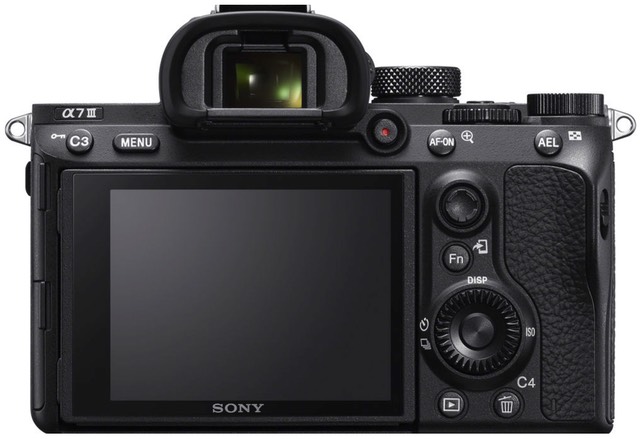
In terms of controls, I’m less than enthused about the Record video (red) button moving next to the viewfinder on a raised platform. As I described to a Sony manager at Kando 2.0, it’s really easy to overshoot the AF-On button and start recording video. At my table at lunch the first day I asked how many had recorded unwanted videos because of this. Answer? All of us. Including the Sony employee lunching with us. Doh!
I don’t mind the position of the video button. That’s a good place for it. But the AF-On button should be on a raised platform and more substantive while the Record video button should be recessed, the opposite of the way it is today. (Note that in that photo, above, the lighting emphasizes how far the AF-On button sticks out; it doesn’t really stick out all that much.)
I already mentioned the touch screen implementation. For touch-to-focus-and-shoot it’s laggy compared to the competitors, even my DSLRs in Live View mode. Likewise using the LCD as a focus touchpad (the joystick is far better anyway).
It’s not all bad news. The new, slightly larger hand grip is much better and gives you a more solid grip on the camera. The addition of the thumbstick to move the focus cursor (or do other things) really helps. Most of the controls are solid and the exposed exposure compensation dial requires real force to move off its current position, which is the way it should be.
I hadn't noticed this before dpreview mentioned it in their review, but we now have the closest thing to in-camera raw histograms to date in the A7m3. Simply put, use Hybrid Log Gamma (HLG) as the Picture Profile and turn on Zebras (set them to 100+). The zebra striping now gives you direct visual feedback as to when you start truly saturating highlights. Of course, if you're shooting raw+JPEG, this means you have to keep switching Picture Profiles (HLG to meter, your usual choice to shoot). Fred Miranda has a simpler approach: put the camera in highlight metering and dial in +2EV exposure compensation. Both seem to work better than relying upon the regular histogram.
I’ve run into a number of people who think the Sony shutter release is mushy and hard to half-press. I don’t agree. It works fine for me. Ditto on my other Sony bodies.
Meanwhile, the PlayMemories App capability is now gone. Also gone is a way to do time-lapse with the camera, unfortunately. I wrote that Sony got PlayMemories wrong back when it was first introduced, and I’m going to stick with that. Unfortunately, the things that should have been built into the camera but were only offered as optional for-money apps are now missing completely. That, too, is wrong.
Now all of this section probably sounds just terrible.
No, the handling on the Sony A7’s is not terrible, but it’s not yet at the level of the Canon/Nikon DSLRs that Sony wants to compete with. This is the third generation of the A7 (and maybe the seventh generation of the Sony menu system in ILC). Guys, what’s the hold up in getting things truly straightened out in the menus?
How's it Perform?
Focus: Sony keeps finding ways to get closer to DSLR levels of focus performance. With some modest caveats, that's true here.
The A7m3 focus system is one I already have some experience with, as it's the same as the A9 in terms of the basics. And that's good news, as the A9's system is quite good.
But here's the thing: Sony stops down the lens to the shooting aperture for AF C (continuous servo) focus. I hadn't really considered that a drawback with the A9, as most people using the A9 for sports would be shooting at or near maximum aperture. But indoor event shooters trying to get a bit of depth of field need to be aware of this. While autofocus can perform down to -3EV (f/2 lens), when you're using f/8 as your shooting aperture, low light autofocus is definitely compromised. It's another of those "footnotes" that appear all throughout Sony's marketing literature and manuals, and it's a doozy if you're not aware of it.
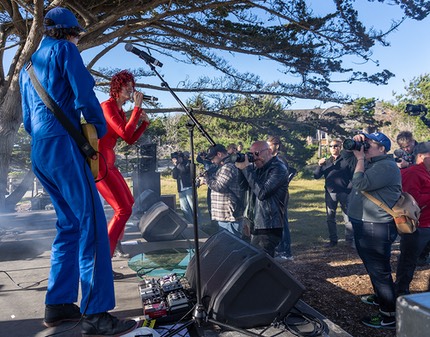
Here's where you want to get out of Face Detect or Eye AF, as the camera will start getting confused. On the other hand, this is where the joystick with right AF mode excels. I'm tough on Sony's focusing (e.g. not yet at DSLR levels), but the III generation is getting close, and it's because of all the options that are in the system now.
In particular, I see people raving about Sony's Eye AF. Yes, that feature works quite well in continuous autofocus if you're at the maximum aperture of the lens and in good light. Change either of those last two things and it starts working less well.
AF S (single servo) focus doesn't have this limitation, but it's also a bit slower than AF C because it performs a contrast-based final step to confirm the focus position (the implication is a 1/120 delay). With quick moving or erratic moving subjects, this is problematic, but with more stationary or slow moving subjects this generally is fine.

One thing about having a good EVF and great contrast detect focus (plus in-camera IS) is that with a little practice handheld macro work becomes easy to get right.
I've looked at a lot of images I shot with the A7m3, plus given that I was under a time deadline due my review unit being a loaner, I looked at as many images from others as I could find, as well. And I see the same thing in both. As with earlier Sony cameras, single AF S shots tend to be spot on in focus though sometimes not timed quite to when the shutter release was likely pressed, while continuous AF C shots tend to wander back and forth a bit from where the focus plane should be. The more you stop down, the more problem that latter bit can become.
A lot of folk will find the timing of the AF S shots and the focus of the AF C shots to be quite acceptable. But neither of these things are at the leading DSLR levels, in my opinion. Sony is getting closer, but they're not there yet.
Thing is, for most people who can't take the time to master all the nuances of the complicated DSLR focus systems (plus control the focus point usefully), the Sony "helpers" (Eye AF, Face Detect, Wide, Zone) would tend to produce "more keepers" than they're used to. This accounts for a lot of the "my mirrorless system focuses better" chatter you hear on the Internet. Well, for them, it does.
Image Quality: The big buzz by bit bangers looking at the latest A7 models has to do with something called PDAF striping. This is an issue that is clearly present on the Mark III A7's and the A9, and probably because of the increase in phase detect focus sensor positions. Basically in backlit conditions light striking the sensor at an angle seems to reveal striping where the phase detect focus sensors live.
Like Sony's compressed raw artifacts, these are a small artifact that once you see it (typically only in a big print), you're going to be annoyed. But you’re not likely to see it. And while there is software that can mitigate the visual impact, this is like "removing noise": no, that's not what we actually do ("remove"); instead we mush up data so the noise isn't visible. That's what we're doing to remove striping, too.
Thing is, I'm not sure why this is rearing its head now. While the Mark III series and A9 can produce more striping visibility due to the increased number of PDAF pixels on the sensor, this defect was in the Mark II versions, too.
And I think that by itself ought to tell you something: it's not going to be something you typically see, and you shouldn't be worried about it. I actually tried to trigger PDAF striping and had a difficult time doing so with any consistency. More often than not in those strong backlit situations that cause it I didn't generate it.
Still, I hate data that has garbage in it, and that's what we have with both Sony's compressed raw and with the PDAF striping. The raw data you collect isn't as clean and defect free as it could be, and as a purist, that bugs me. I've been known to do some pretty extreme post processing at times, and I want to start with the best possible data, not have to worry whether I might someday find my road blocked by a very low level artifact.
So I'm going to say this: Sony needs to pay a little more attention deep down in the data to make me perfectly happy. But most of you are going to be perfectly happy even if they don’t.
Oh, and file size? Sony needs to figure that out, too. The A7m3 nets 25MB images in compressed raw, and almost 50MB images in uncompressed. Compared to a Nikon 24mp sensor camera, those file sizes are huge (the D750 comes in at about 27MB for 14-bit lossless compressed, the top raw setting on that camera, and can be as little as 19.2MB for 12-bit compressed). And as I noted, the compressed A7m3 image can have high-contrast edge artifacts.
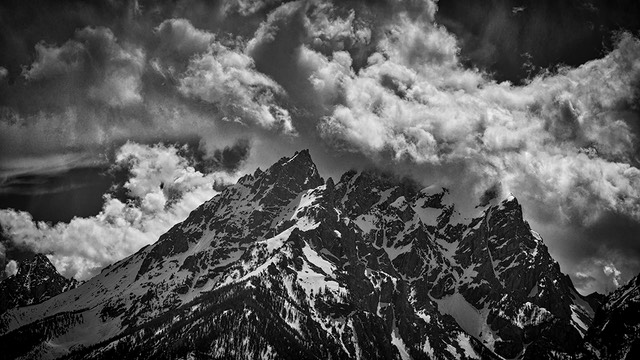
One of the things I enjoy with the Sony A7m3's sensor is that when I really push the heck out of image tonal values in black and white, they hold up really, really well. That black sky is really blue sky pulled down enormously. Often when you do that you get lots of noise to deal with. Not so with this Sony. At the other extreme, look at the subtlety in the cloud highlights that are still being held as I worked the highlights.
Don't believe I really whacked the tonal curves to great extremes? Well, here's the original just as it came into ACR:
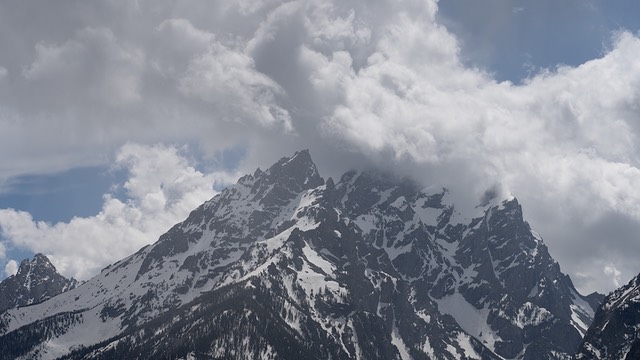
Which brings me to this: the full frame 24mp Exmor family—variations of which have been used on cameras such as the Nikon D610, Nikon D750, Sony A7 (I, II, III), and Sony A9—is a mighty fine family. Versus the Nikon D750, the A7m3 gets perhaps a half stop gain in dynamic range at ISO 640 and above, due to the addition of dual-gain in the new Sony sensor (the D750 is single gain). Other than that, they're remarkably close. In terms of consumer-priced cameras, nothing really tops that in full frame.
If anything, the A7m3 has more ability to boost shadows without seeing the dreaded magenta shift and lots of noise than does the D750, which is well regarded. Both are better than the Sony A9 at this, by the way. Moreover, I'd be darned tempted to set auto ISO on this camera to ISO 640 max. Or just set ISO 640 as my typical base (you'll get something slightly better than even ISO 400 in terms of dynamic range if you did. Are you really shooting at ISO 100 and 200 and to max out the dynamic range? If not, the nearly 10 stops you get at ISO 640 is probably more than enough.)
In terms of JPEGs, Sony gets better with each generation in processing them. This latest generation of cameras actually seems to have a bit of a dual hue shift behind it in the defaults, making it look a bit more Canon-like in color than Nikon. Greens go a little yellow while reds rotate a bit back towards yellow, too.
You can't win the color model game, though. For everyone who likes one rendering, there's another who prefers something else. Personally, I like dead neutral color in my data, because getting shifts out is far harder than putting them in. Plus then there's the issue of how accurate your white balance is.
While dpreview claims Sony now has the best noise handling and sharpening in JPEGs, that, too is a subjective kettle of squirming worms I don't think you want to dive into very deeply. I'll say that Sony's noise reduction has improved, but I'm not sure their sharpening is optimal. That's particularly true on the A7m3 because of the very weak AA filtration (it only filters on the horizontal axis, not vertical): I see low level moire and color fringe at times, and Sony's sharpening will absolutely make those visible if you're not careful. That said, I agree with dpreview in that Sony has made big strides here and the JPEGs can be quite good coming out of the camera if you watch your white balance carefully.
The major thing I'd caution you to be aware of with image quality is when using the silent electronic shutter: in most frequency-based lighting you will often get highly visible banding that is not really correctable in post. While I mentioned that in my A9 review, the A7m3 seems far more prone to this. That's because the stacked sensor in the A9 reads out in about 1/160, the A7m3 ranges from 1/20 to 1/30 second or so (different image quality settings impact this).
One thing I hate about reviewing the Sony cameras is that we got lost in the weeds of footnote-type discussion. There's another one I haven't mentioned about image quality: loss of dynamic range shooting compressed raw in continuous modes. Instead of reading 14-bit data from the sensor, the camera reads 12-bit data when you set this, and dynamic range definitely and measurably drops, and at the lower ISO values that loss is clear (a stop or more). I've mentioned optimal data several times, and if that's your goal, then there's a lot you have to be aware of on the Sony bodies; more so than on the Canon/Nikon bodies.
Finally, we have the Star Eater issue. Nikon used to have this same problem until Marianne Oelund provided Nikon with a better hot-pixel fix. Basically, starting at four second exposures, Sony is doing some sort of hot pixel suppression that will eat low-level stars in astrophotography. It’s not nearly as bad as it once was in the early Sony models, but it’s still present, just not very visible any more.
These little image quality gotchas are all a shame, because overall, most shooters are never going to see all these little gremlins living deep in the bits (silent shooting in frequency-based lighting being an exception: you'll almost certainly see that at some point if that's how you shoot). I regard the image quality of the A7m3 as being high. Quite high. Certainly at or near the top of the class for 24mp full frame. I simply wouldn't worry much about any of the problems that keep getting lots of discussion on Internet fora, including here.
Indeed, you can pretty much eliminate all of them by: (a) shooting uncompressed raw, (b) shooting only with the mechanical shutter and at faster than 4 second shutter speeds, and (c) being careful to avoid off center light sources in the frame.
Video Quality: Generally I don't mention video quality in my reviews, but I suspect the A7m3 is going to be a vlogger camera for many, so at least some quick comments are in order.
The downsampled 4K looks really good, and at 24 fps you're shooting at full frame, which definitely has low light and shallow depth of field implications that are positive. I wish we had better than 4:2:0 color, more than 8 bits for storage, and better compression routines than Sony’s usual ones, but for what we do have the results are about as good as I see out of still cameras. Rolling shutter is okay at 24 fps and better at 30 fps, but isn't really suitable for pans and fast action, IMHO.
Final Words
Okay, here we go. Virtually every other review that has come out has managed to anoint the A7m3 as the full frame camera to beat. Somehow all those reviews managed to make it out in days after the camera appeared, too ;~).
I happen to think the A7m3 is a fine camera. It personally wouldn’t make me give up a Nikon D750, but that would mostly be due to a decades old and refined ergonomic design versus what still feels to be a company searching for the right ergonomics.
That truly is the factor that I think determines whether you’re going to find the A7m3 the camera for you or not: can you really tolerate the menus, the small buttons, the poor touchscreen implementation, the obscure nomenclature, and no clarity on what some function choices actually do (automatic versus manual keeps surfacing over and over in the menus)?
Thing is, when you shoot with the A7m3 for awhile, as I have with this review—and also note that I’ve been shooting with the bigger brother but very similar A7Rm3 for half a year—you eventually get the camera configured the way it works for you, you learn to decipher and navigate the SonySpeak in the menus, and you just (mostly) adjust to the buttons. Assuming you don’t need to handle the camera in rain or snow or with gloves on, the small buttons and use of the Direction pad dial as buttons can be adjusted to.
Your payoff for that patience is a camera that can shoot just about anything well, and with image quality that rivals or beats any other 24mp camera. Seriously, it’s the image sensor that redeems this camera. The Canon 6D Mark II can’t produce the level of useful information that the A7m3 can, in my opinion (though beware the Sony footnotes and learn how to avoid them).
The Nikon D750, on the other hand, can mostly hold its own in image quality against the A7m3, and that’s just startling considering how old the D750’s sensor now is. The A7m3 really only tops the Nikon with a narrow benefit due to dual gain at high ISO values and all the attention to better video. The D750 beats the A7m3 in ergonomics.
It’s going to be interesting to watch the next half year or so. Canon and Nikon are both rumored to be coming right into the A7m3’s price point and capability list with new mirrorless offerings. As I write this, Sony is all alone with a US$2000 full frame, entry-level mirrorless camera, and both the price point and the capabilities really make it an overall winner that anyone thinking about a camera at that price point has to consider.
I’ve seen a lot of accolades thrown at the A7m3. For example: an A9 for less than half price. I’d say there’s a lot of exaggeration going on, and I suspect many of those making that claim haven't actually used an A9, let alone tried any of its pro-level features (e.g. FTP via Ethernet).
That said, the A7m3 reminds me a lot of something like the Honda Accord or Toyota Camry in the automobile market: not the absolute best products you can find, but as a daily driver, they're highly competent and priced right. So is the A7m3. That’s a compliment. A high compliment, actually.
I expect the A7m3 to be a best seller, much like those autos I just mentioned. Indeed, the initial shipment into the US sold out almost instantly.
The A7m3 is well rounded, does the intended job quite well, and won’t max out your credit card (though watch out for buying lots of new lenses to put on it). I wish Sony had gone further with improving the ergonomics in this third generation of cameras, but there were improvements, just not as many as I (and others) might have wanted.
So, yes, the A7m3 should be on your candidate list if you’re considering full frame. High on your candidate list.
Recommended (2018, 2019, 2020, 2021) however strongly consider the newer Mark IV or Mark V models